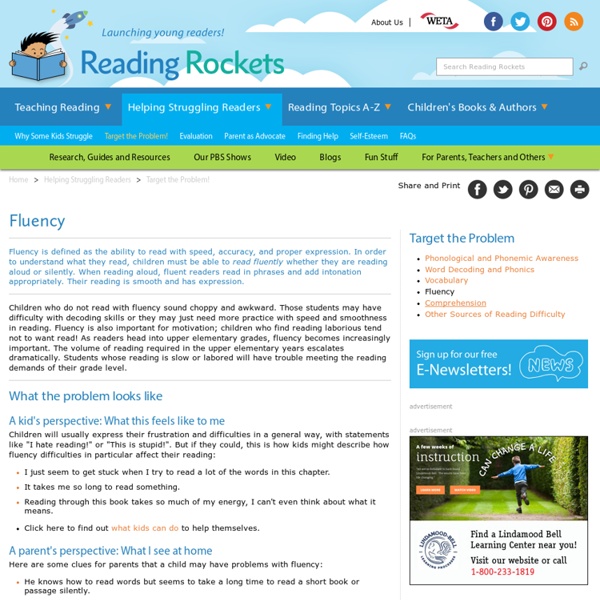Zoom
Trash
Related:



Understanding and Assessing Fluency Let's cut through the buzz around fluency and review what reading fluency is, why it is essential to ensure that our students have sufficient fluency, how fluency should be assessed, and how to best provide fluency practice and support for our students. We'll start by defining fluency. While the National Reading Panel's definition of fluency as the ability to read text with accuracy, appropriate rate, and good expression (NICHD, 2000) is widely accepted among fluency researchers, these experts continue to debate the more subtle aspects of fluency (Stecker, Roser, and Martinez, 1998; Wolf and Katzir-Cohen, 2001). However it is defined, this much is certain: Fluency is necessary, but not sufficient*, for understanding the meaning of text. When children read too slowly or haltingly, the text devolves into a broken string of words and/or phrases; it's a struggle just to remember what's been read, much less extract its meaning. Student placed vocal emphasis on appropriate words.
Reader's Theater Scripts and Plays for the Classroom Reader's Theater Scripts and Plays Readers Theater is a dramatic presentation of a written work in a script form. Readers read from a "script" and reading parts are divided among the readers. No memorization, costumes, blocking, or special lighting is needed. Presentations can easily be done in a k-3 classroom. Scripts are held by the readers. "Reader's Theater proved to be almost a magic solution for Griffith: In just 10 weeks of using RT, every child in her class had gained a full grade level in reading. Update - July 08
Primary Press: Presidents and a Sight Word Freebie We are working like crazy this week to get in all of our presidential fun! You can get the sight word centers here {for free!}. Please let me know if you are able to use these! They go along with the 100 most common words that we use in our small groups. You can get my Presidents' Day workshops and thinking maps here.
Another great practice for fluency, Reader's theater! A variety if options. Reader’s Theater Editions are free scripts for reader’s theater (or readers theatre) adapted from stories written by Aaron Shepard and others—mostly humor, fantasy, and world tales from a variety of cultures. A full range of reading levels is included, with scripts aimed mostly at ages 8–15. The scripts may be freely copied, shared, and performed for any noncommercial purpose, except they may not be posted online without permission. As noted in the listing, some scripts come also in a “Team Version,” scripted for four readers with at least two females. These scripts are offered primarily for smaller groups such as after-school programs and homeschoolers, as well as for college and professional readers. Special features are available for many scripts.
ELLs and Reading Fluency in English Fluency is the ability to read words accurately and automatically with expression. Because fluent readers do not have to slow down in order to concentrate on decoding the individual words in a text, they can focus their attention on the text's meaning. In this way, fluency acts as a bridge between word recognition and comprehension, and this relationship is reciprocal. That is, when a student understands the meaning of the text he/she is reading, it is much easier to read that text with expression. Prosody is a term that is frequently heard in discussions of fluency. How fluency relates to ELLs Instruction in fluency can be particularly beneficial for English language learners because activities designed to enhance fluency in reading can also contribute to oral language development in English. Assessing reading fluency As with any type of instruction, fluency instruction depends upon ongoing assessment to identify individual students' strengths and needs. Assessing reading accuracy
This is a tool to assess student's fluency. This is for the teacher, not for the student. Reading fluency norms can serve as a stable benchmark for reading fluency. Give OFA tests three times a year, fall, winter, and spring, to monitor progress over time. What Is an Oral Fluency Assessment Norm? A norm is a standardized score that is determined through the collection of scores of many different students at the same grade level. The oral fluency norms that are used in this lesson are derived from the scores of students in eight racially and economically diverse districts. What Do the Percentiles Indicate? Fluency Goals for the End of Grades 3-5: 3rd Grade (Spring): 114 WCPM. 4th Grade (Spring): 118 WCPM. 5th Grade (Spring): 128 WCPM. Use the Oral Fluency Assessment Calculator when you administer tests with your students. Administering an Oral Fluency Assessment, Grade 3 (PDF)Administering an Oral Fluency Assessment, Grade 4 (PDF)Administering an Oral Fluency Assessment, Grade 5 (PDF)
Yet another Reading Rockets page--I love this site!--this one for helping struggling readers. by mcussen Feb 16
This website helps for all of reading but I picked it for fluency. It shows activities to do before, during and after activity and it also gives you assessment data. by trrockford Nov 5
Reading rockets website contains information and exercises for increasing reading fluency. by bmahieu Sep 17